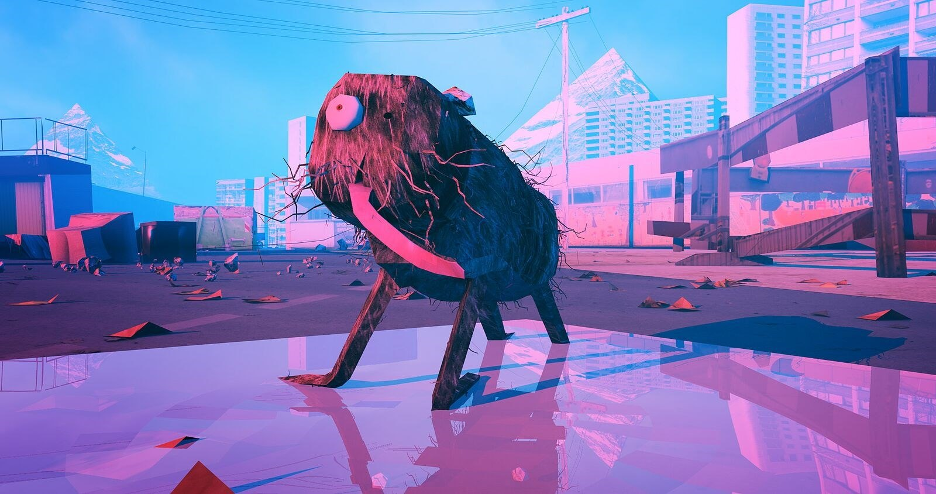The Anthropocene reveals the ways in which our day-to-day perception of what constitutes ‘normal’ misleads us, as we require time lapse footage to render the melting ice caps perceptible to our biologically limited temporality, for example (see Ehrlich 2021, 42). Media that meaningfully engages with the Anthropocene requires the depiction of scale and space beyond what human vision will allow; a green cultural shift requires a population with the capacity to observe and appreciate reality from a variety of scales and perceptions (see Clark 2015, 29). Satellites and drones provide visions of the world without direct human intervention, while the legion of bots on the internet draws increasing attention to non-human perspectives. Advancing technology problematizes the assumptions which align beauty with nature and artifice with ugliness, as audiences become acclimated to information that falls outside human vision (see Ehrlich 2021, 42). Likewise, a failure to understand reality based on a variety of experiences leads to the belief that the planet can be saved by well-intentioned individuals, echoing the plots of such animated films as Fern Gully (1992) or The Lorax (2012), which simplify the Anthropocene’s complexity by presenting the main characters as separate from the natural world (see Clark 2015, 37). Navigating concepts from a variety of perspectives will become a central aspect of the Anthropocene. Non-human experiences can no longer be ignored as everyone (and everything) contends with the rising water (see Morton 2013, 22).
In 3D CGI animation, for example, the division between sentient and non-sentient entities often exists on the material level of production. Characters are animated with a combination of motion-capture and key-frames, while natural phenomena typically move via nonlinear simulations, in which a computer generates dynamic interactions for animating water or explosions (see Gowanlock 2019, 62). It is precisely the computational complexity of these simulations which has allowed studios such as Pixar to dominate, coding software in-house to animate such material realistically. These simulations represent an element of non-human experience in the animation process, although careful illusionism works to make this animation fall within the realm of believability, aligning the machine’s perception with the human’s one. Animation that addresses the Anthropocene must decenter both the human perspective and the concept of human mastery within the medium itself in order to dissolve the mythical division between man and nature.
Nikita Diak�r actively complicates human and non-human perception, printing his name with a uni-code error glyph to call attention to the ways his identity as an artist is already filtered through a digital interface. The film Ugly (2016) tackles a dangerously sentimental topic, depicting the abuse and murder of a stray cat as an allegory for man’s callousness towards the ecological havoc they have wrought. Yet, the potential sappiness is undercut by bizarre design and jittery animation. Rather than solely relying on nonlinear simulation to animate natural phenomena, soft character bodies were attached to off-camera controllers with bouncy digital strings. Affixing the camera to something physical, such as a car or a person, allowed the nonlinear simulation to impact camera motion (see Diak�r 2016). Ugly also incorporates randomness into its design process with characters appearing as if drawn with the artist’s non-dominant hand while photographic textures projected onto polygonal shapes warp and stretch under the forced perspective. The models of characters frequently break, a giraffe’s mesh warps, while bad binding creates a glitch that gives the stray cat a persistent motion blur. This allows the film to convey the contingent and random elements of digital animation, calling attention to the constructed nature of the final film, while de-emphasizing the animator’s ability to determine the final product.
Ugly rejects traditional notions of human mastery and agency on the material level of production, using non-human perception to convey an environmentally motivated message. Studios such as Pixar and Disney have waded into the topic in a family friendly manner, even though some films from the 1990s proved so heavy-handed that many parents and guardians reacted negatively (see M. 2020). Ugly, instead,addresses its didactic function in a manner more akin to the intellectualistic theater of Bertolt Brecht, in which the glitches render the digital nature of the film apparent, rejecting illusionary or naturalistic approaches to estrange audiences from the otherwise familiar (see Jameson 1998, 39). It is precisely this estrangement which is necessary to introduce audiences to the complex nature of the Anthropocene, animating in such a way as to undercut the division between simulated and intentional motion, and by extension the divide between artifice and nature. While Ugly‘s ecological messaging is couched in a parable about human cruelty, it combines narrative methods designed to evoke sympathy with alienating visual design to overcome limitations exhibited in other environmentally-motivated animation. Experiments such as Ugly represent a novel avenue for animation invested in ecological messaging in the Anthropocene, a phenomenon that remains inscrutable without the capacity to comprehend the world through non-human experiences, and Ugly demonstrates the ways in which the animated medium can excel in the depiction of the anthropomorphic and the simulated.
References
Clark, Timothy. Ecocriticism on the Edge: The Anthropocene as a Threshold Concept. Bloomsbury, 2020.
Diak�r, Nikita, director. Making Ugly. Youtube.com, Maxon, 28 Sept. 2016, https://www.youtube.com/watch?v=qKLoO6e9EOE. Accessed 12 Sept. 2022.
Ehrlich, Nea. Animating Truth: Documentary and Visual Culture in the 21st Century. Edinburgh University Press, 2021.
Gowanlock, Jordan. “Animating Management: Nonlinear Simulation and Management Theory at Pixar.” Animation, vol. 15, no. 1, 2020, pp. 61–76., https://doi.org/10.1177/1746847719898783.
Jameson, Fredric. Brecht and Method. Verso, 1998.
M., Stephanie. “The Complex Lessons of Environmentally-Motivated Animation.” The Artifice, 27 Nov. 2020, https://the-artifice.com/animation-environment/.
Morton, Timothy. Hyperobjects Philosophy and Ecology after the End of the World. University of Minnesota Press, 2013.
Colin Wheeler, Ph.D., researches media industry discourse when he is not working as a freelance animator in Georgia, combining theoretical with practical knowledge to explore animation production practices. Currently working on short animated documentaries, he likes writing about and making weird films and television.


1 comment for “The Ugly Anthropocene: Animated Simulation and Non-Human Perspectives”